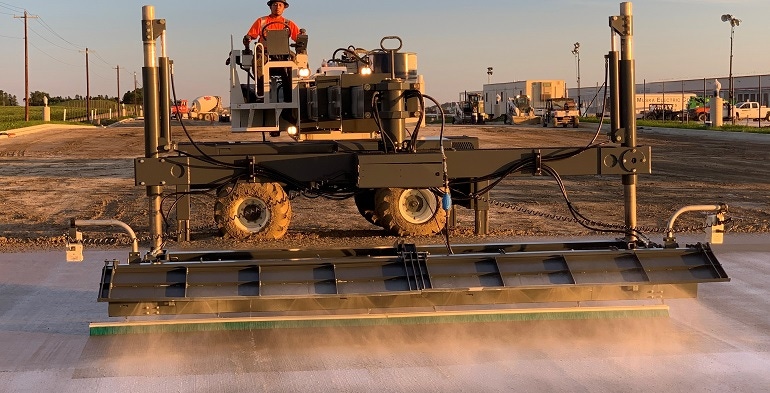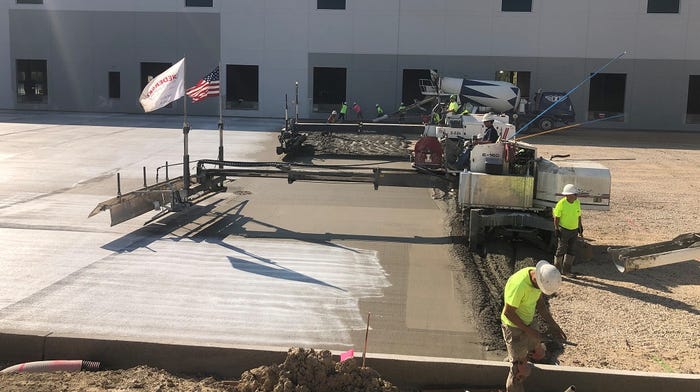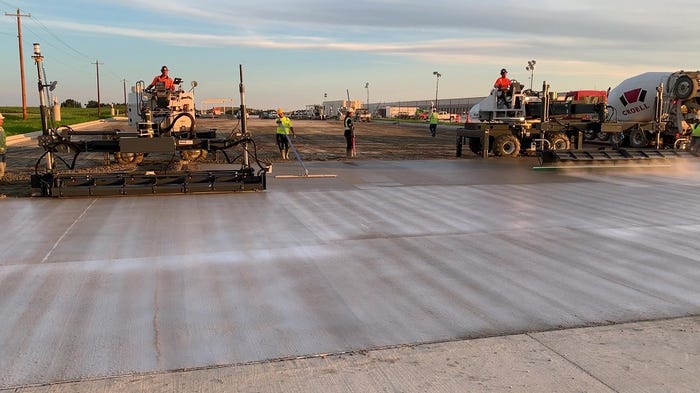Industrial concrete pavement has new equipment that will increase quality and productivity, the Somero Broom + Cure machine that follows concrete placement within minutes and saves manpower.
November 6, 2020

Industrial concrete paving is a booming new market for concrete contractors. Jon Hansen, senior vice president of local paving at the National Ready Mixed Concrete Association, has been a strong voice for concrete pavements and overlays for many years and his efforts are now bearing fruit. NRMCA’s Design Assistance Program offers free design advice for new concrete pavements and concrete overlays and this service has allowed many projects to flip from asphalt to long-lasting concrete.
But as with many construction projects, decisions are often made based on first cost. Today, concrete can even compete there while still providing a higher quality and more durable product. Contractors are placing remarkable exterior industrial pavements of millions of square feet and doing it in record time, typically using 3D laser-guided screeds. But curing, applying texture, and saw cutting these big pavements is a huge part of the job and has a big impact on the profitability.
Now there is a new device that helps to simplify some of those tasks. Somero’s new Broom + Cure machine, based on the Somero SXP Laser Screed platform, applies texture and curing agent in one operation and does it within minutes after concrete placement with a Laser Screed.
The path to development of this machine was a little unusual. Scott Swederski, president of Swederski Concrete Construction, had a large industrial pavement project, 1.2 million square feet, that specified use of a white water wax curing agent. He knew that this material worked well but unless it had ample time to dry it gummed up his saws during joint cutting. The challenge was how to get the cure onto the pavement as quickly as possible so it would be dry by the time the sawing operation began. His brainstorm was to use a laser screed platform with a texturing bar and a cure sprayer to allow application of the cure very early in the operation. He took this idea to Somero but at the time their R&D department was involved in other innovations. So Swederski decided to make it himself.

"I stripped down an old Somero 160 Laser—outdated, but still worked—and modified it for the broom and cure,” says Swederski. “I lightened up the head so I could reach out 2 feet farther than the screed could reach so I wouldn’t have to wait to apply the curing agent. We did a test in our yard and it worked perfectly the first time. My machine has two 90-gallon aluminum tanks for the curing compound. This allows us to place over 44,000 square feet without refilling or trying to place drums on the machine when every second counts. When you are getting trucks every 3 minutes, it doesn’t take long to fall behind. We can refill as fast as Nascar does in the pits, usually without spilling a drop.”
And Swederski isn’t done innovating yet. “I think there are more opportunities for my texture and cure machine than just pavement,” he says. “One of the reasons I installed a flow meter is because we have been getting into applying liquid floor hardeners as we place interior floors, such as Multiquip’s Slab Armor that is finished into the surface. I feel there is great potential to compete with dry shake-on hardeners that are messy and becoming a thing of the past with all the different shrinkage comp/high density floors out there now.”
Soon word got out about the broom and cure and Somero began receiving calls asking for one of these machines. “I had been working on ideas and concepts for years to solve these issues,” says Myron Hillock, Somero’s sales director, “but out of the blue Scott Swederski came up with his concept and it put my ideas to shame. He nailed it. I was not aware you could broom and apply the cure that quickly. Many had doubts, but Scott perfected it over two seasons and Somero worked with his concepts and a few of our own ideas which now leads to mass production of these machines. This is going to revolutionize the paving industry in so many ways, and ultimately the client / owner gets a higher quality pavement.”
Somero sent prototypes of their new machine to K&M Concrete, Edgerton, Minn., and to Scurto Cement Construction in Chicago. “We wanted to have some other contractors test the prototypes,” says Hillock, “but they wouldn’t give them back.”

“One of the most significant benefits we have experienced using the Somero Broom + Cure is the timing and application of a curing membrane,” says Michael Hoeft, Director of Business Development with K&M Concrete. “We are getting controllable application within 15 to 20 minutes of concrete being discharged from the mixer truck. It also eliminates 2 to 3 men chasing around with a telehandler and spray rig to apply cure in addition to any associated safety issues.
“We are placing concrete with a Somero S-22EZ followed with a standard bull float finish, followed by our Broom + Cure machine. With a place and finish crew of 12 we have had nightly production rates as high as 83,000 square feet and over the 2.2 million square foot project will average about 55,00 square feet per shift. Our most important learning experiences have been understanding the placing environment, that is the wind, temperature, humidity, and dust that can have a significant impact on concrete materials. Slump control is critical; we had a dedicated person at the batch plant who was responsible for ensuring consistent slump and broom choice: bristle stiffness and angle of attack.
“As an industry we need to make sure we fully engage our customer regarding finish expectations related to mass site and parking lot pavements to dispel the ‘patio finish’ as a standard. The reality is that this finish is not safe or conducive to traffic pavements and drives costs up significantly which as an industry needs to be addressed if we have any hope of being competitive with asphalt on initial cost. In the northern climates we need to provide as much surface profile as possible to compensate for the added surface erosion encountered from snow removal equipment. Simply put, concrete pavement aesthetics are NEVER worse than the day following placement, when broom overlaps and minor surface imperfections are obvious. A month later the pavements look good and a year down the road they look awesome!”
Somero has sold eight Broom + Cure machines to date. “Our biggest problem right now,” says Hillock, “is we can’t make them fast enough.”
You May Also Like


